通用英语语法PPT课件
合集下载
小学英语语法课件-疑问句 (共29张PPT) 全国通用
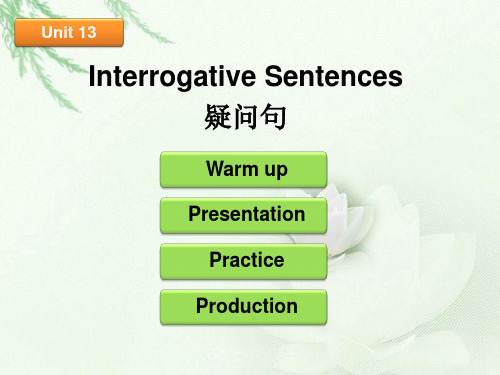
Presentation Grammar Box
Presentation Grammar Box
Presentation Grammar Box
Presentation Grammar Box
Presentation Grammar Box
Presentation Grammar Box
A. What
B. When
C. Where
D. Which
Production Quiz
Production Quiz
Practice Oral Practice
选择正确的答语。
A. By car. B. Yes, she has. C. Yes, I do. D. It’ s 10 dollars. E. He is my brother.
( E) 1. Who is he? ( A) 2. Do you go home by car or by subway?
Practice
Exercise 2
aren't you
Practice
Exercise 3
Practice
Exercise 4
5
PPrraaccttiicceeI Exercise 1
特殊疑问句 一般疑问句 一般疑问句 一般疑问句 反意疑问句
Practice
Exercise 2
aren't you didn’t she
My grandma has been to many places, _h_a_s_n_’_t _s_h_e_? Lily and Lucy will go to school next week, _w__o_n_’_t _th_e_y__?
英语语法讲解ppt课件

sentences more vivid and powerful.
05
Sense structure
Subject+predict
The subject+predicate is the basic structure of a simple sentence, expressing a complete idea.
in English
To improve English writing and speaking skills by applying graphical knowledge
To enhance English language comprehension
and reading ability
02
Form
The passive voice is composed of the auxiliary verb be (am/is/are/was/were)+past participle, and the tense is expressed by the change of the be verb.
Subject+predict+object
The subject+predicate+object is an extended structure of a simple sentence, expressing the complete idea and the object involved in the action.
Part of Speech
Noun
01
02
03
Noun
A word that names a person, place, thing, or idea
英语语法基础用ppt课件

Eg:1)朝辞白帝彩云间。 2)千里江陵一日还。 3)两岸猿声啼不住。 4)轻舟已过万重山。
1)Tom is an expert driver. 2)He drives fast. 3) There is a book on the desk. 4) Here comes the bus. 5) Never will I do it again. 6) It drives me mad to teach her. 7) Teaching English is my job. 8) What he said isn’t true.
T, following the dog.
一个句子中的基本成分 6、补语:补充说明主语/宾语的性质,使句意完整。
I found the explanation wrong.(宾补) He often calls the dog “wangwang”.(宾补) He died young.(主补) The bottle was found empty. (主补)
2 英语语法概述
语法的本质= 造句
一个句子 = 一部电影 十大词类 = 十个演员 七大成分 = 七个角色
名词 代语 名词性从句 非谓语动词
名词
形容词 介词短语 定语从句 非谓语动词
句子
时态
动词
被动 虚拟
情态 主干
副词
修饰
介词短语
状语从句
非谓语动词
一个句子中的基本成分
1、主语:句子的主角 谁是主语 = 这句话在说谁
一个句子中的基本成分 5、状语:在句子中表示时间、地点、原因、方式、 程度等状态的成分(把句子壮大)。
He speaks English well. The sun rises in the east and sets in the west. I love English, because it’s interesting.
1)Tom is an expert driver. 2)He drives fast. 3) There is a book on the desk. 4) Here comes the bus. 5) Never will I do it again. 6) It drives me mad to teach her. 7) Teaching English is my job. 8) What he said isn’t true.
T, following the dog.
一个句子中的基本成分 6、补语:补充说明主语/宾语的性质,使句意完整。
I found the explanation wrong.(宾补) He often calls the dog “wangwang”.(宾补) He died young.(主补) The bottle was found empty. (主补)
2 英语语法概述
语法的本质= 造句
一个句子 = 一部电影 十大词类 = 十个演员 七大成分 = 七个角色
名词 代语 名词性从句 非谓语动词
名词
形容词 介词短语 定语从句 非谓语动词
句子
时态
动词
被动 虚拟
情态 主干
副词
修饰
介词短语
状语从句
非谓语动词
一个句子中的基本成分
1、主语:句子的主角 谁是主语 = 这句话在说谁
一个句子中的基本成分 5、状语:在句子中表示时间、地点、原因、方式、 程度等状态的成分(把句子壮大)。
He speaks English well. The sun rises in the east and sets in the west. I love English, because it’s interesting.
英语语法PPT课件
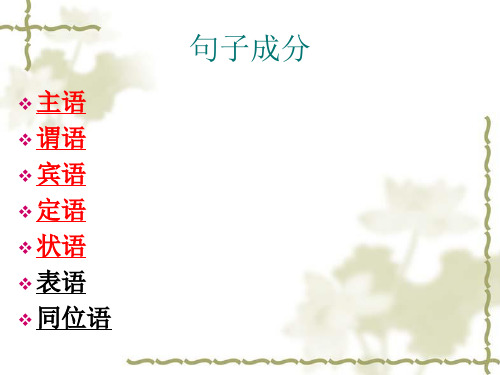
谓语
➢ 定义 谓语表示主语所做的动作或所处的状态。
➢ 分类 (1)简单谓语
(2) 复杂谓语
❖ 简单谓语:凡由一个动词(或动词词组)构 成的谓语都是简单谓语
Eg I like walking.(一般现在时主动语态)
I made your birthday cake last night. (一般 过去时主动语态)
carefully. ❖ China does not want to copy the USA’s
example.
✓ 代词
❖ It’s a young forest. ❖ I don’t know if it will grow. ❖ That’s a bit expensive. ❖ You’d better buy a new pair. ❖ I’m afraid we haven’t got any black shoes.
持续 He always keeps silent in class. This matter rests(remains) a mystery.\
表象
• He looks tired. • He lost his girlfriend so he seems to be very sad. 感官
rainy.(天气) ❖ How far is it? It’s about one kilometer away. (距
离)
✓ There be 句型中,be 作谓语,主语位居其后 ❖ There are many different kinds of
mooncakes. ❖ There will be a strong 语补足语)
有些及物动词除跟一个宾语外,还需要加上 宾语补足语,否则意思不完整,它们一起构成复 合宾语,复合宾语中宾语和后面的宾语补足语 有一种逻辑上的主谓关系,这也是判断是两 个宾语还是复合宾语的依据,宾语可以由名词 或起名词作用的词担任。
英语语法:定语、状语、补语ppt课件

可编辑课件PPT
6
不定式短语作定语
不定式 不定式的基本形式:to+动词原形。 I have nothing to worry about. 我没什么好担忧的。
He gave me some books to read. 他给我一些书看。 注:不定式不能做谓语。
可编辑课件PPT
7
不定式作定语
Do you have anything more to say? 你还有什么话要说吗? There is nothing to worry about. 没什么好担心的。 I have a lot of homework to do. 我有很多作业要做。
可编辑课件PPT
9
句子作定语
句子作定语即是定语从句 She has found the necklace that she lost
two weeks ago. 她找到了两年前丢的项链。 It happened at the time when I left the
office. 这事就发生在我离开办公室之时。
可编辑课件PPT
10
状语
状语用来修饰动词、形容词或副词。 表示行为发生的时间、地点、目的、 方式、程度等。可作状语的有:副词、 介词短语、不定式、分词、形容词、 词组、复合结构、从句。
可编辑课件PPT
11
副词作状语
Speak politely.说话要有礼貌。 It is very nice of you.你真好。 Read loudly.大声读。
定语、状语、补语
定语
用来修饰名词或代词,可分为前置定 语和后置定语。一般由形容词、形容 词性物主代词(my、his、your、her 等)、数词、介词短语、不定式短语、 分词或句子充当。
小学英语语法课件-基数词和序数词 (共24张PPT) 全国通用
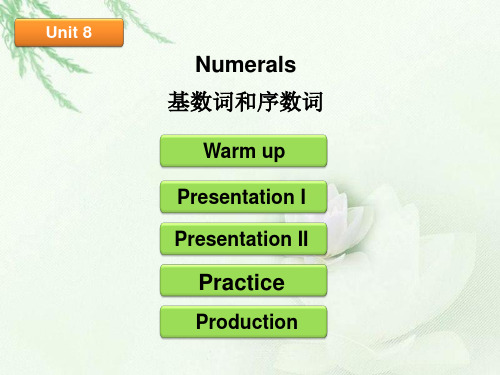
(C)1. — Peter, how old is your father this year? — ___. And we just had a party for his ____ birthday last weekend. A. Fortieth; forty B. Forty; forty C. Forty; fortieth
序数词口诀
序数词这样变 基数词加th 面貌全非1,2,3 8减t, 9减e f替ve, ty变成tie 若要变成几十几 只变个位就可以
Production Grammar Show
seven twelve sixty twenty-four one hundred
Production 小升初真枪实练
(A)2. All the teachers live on ___ floor.
A. the second
B. two
C. second
Production Quiz
Production Quiz
分享有趣的文化差异
number one
number two
go to fourth
屏幕上呈现“厕所”二字,让学生尽快尽可能多地查阅它的表达方法,老师并 将知道的写在黑板上。 学生可能会说出washroom, water closet, restroom, ladies’ room(女厕所), women’s room (女厕所), men’s room(男厕所),public comfort station等。 之后老师再呈现出number one 在屏幕上,让学生猜其意思,也可以查字典。 老师可以告诉学生number one (小便)是在美国学生中广泛流行的说法。 随之老师呈现number two (大便)让学生猜意。再呈现go to fourth(上厕所), 说明这一说法源于19世纪英国剑桥大学的笑话,当时的学生早晨的常规活动是: 做礼拜,用早餐,吸烟,上厕所。这相当于three to get ready and four to go(前三件事做准备,第四件事上厕所)。
小学英语语法精品课件系动词实义动词和助动词30全国通用ppt
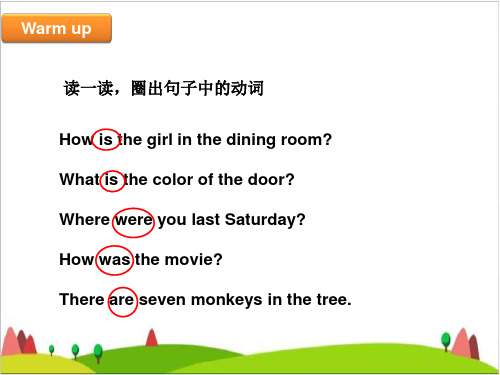
watched
looks
aren’t playing
tasted
Practice Oral Practice
( ) He was to school last week. A B C ( ) Has he finishing the book? A B C ( ) Do he like growing flowers at home? A B C D
特殊疑问句: 特殊疑问词+ do/does+主语+实义动词原形+其他? 特殊疑问词+助动词+主语+动词形式+其他?
What do you like? Where has he been?
Presentation Grammar Box
Practice Oral Practice
Su Hai _______ (want) to take some photos. I ___________ (watch) a running race now.
wants
am watching
did
do
visited
have
learnt
have learnt
likes
doesn’t like
改错,并朗读正确句子
A
B
A
把was改为“went”
把finishing改为“finished”
把Do改为“Does”
( ) Lucy didn’t worked on computer just now. A B C D ( ) Bill and I have learning dance class for 4 years. A B C D ( ) Was your brother go shopping last night? A B C D
looks
aren’t playing
tasted
Practice Oral Practice
( ) He was to school last week. A B C ( ) Has he finishing the book? A B C ( ) Do he like growing flowers at home? A B C D
特殊疑问句: 特殊疑问词+ do/does+主语+实义动词原形+其他? 特殊疑问词+助动词+主语+动词形式+其他?
What do you like? Where has he been?
Presentation Grammar Box
Practice Oral Practice
Su Hai _______ (want) to take some photos. I ___________ (watch) a running race now.
wants
am watching
did
do
visited
have
learnt
have learnt
likes
doesn’t like
改错,并朗读正确句子
A
B
A
把was改为“went”
把finishing改为“finished”
把Do改为“Does”
( ) Lucy didn’t worked on computer just now. A B C D ( ) Bill and I have learning dance class for 4 years. A B C D ( ) Was your brother go shopping last night? A B C D
小学英语语法课件- 一般将来时 (共36张PPT) 全国通用
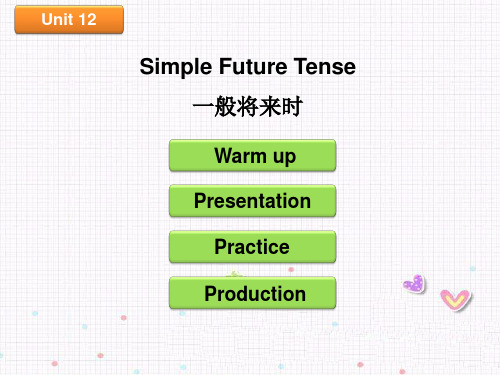
Presentation Sentences
She will take swimming lessons in this vacation. 她今年假期要去学游泳。 She is going to go shopping tomorrow. 她明天要去购物。 Jim will open a shop on internet. 吉姆打算要在网络上开个店。 Jim is going to be an actor when he grows up. Jim长大了想当一名演员。
___t_o_m_o_r_ro_w_.____________________________ 一般疑问句:A__re_t_h_e_c_h_il_d_re_n_g_o_i_ng__to__w_a_tc_h_a_d_o_l_p_h_in_s_h_o_w__
t_o_m_o_r_ro_w_?____________________________ There will be a great concert next week. 否定句:_T_h_e_r_e_w_il_l _n_o_t b_e__a_g_re_a_t_c_o_n_ce_r_t _n_ex_t_w_e_e_k_. ______ 一般疑问句:_W_i_ll_th_e_r_e_b_e_a_g_r_e_a_t _co_n_c_e_rt_n_e_x_t_w_e_e_k?______
Practice Oral Practice
小组合作完成单项选择,并朗读句子
( C ) There __________ a meeting tomorrow afternoon.
A. will be going to
B. will going to be
C. is going to be
基本英语语法大全PPT课件PPT42页

各时态中的
“四大基本句型”
.
1第2页,共42页。
什么是四大基本句型
1 主动句型:主语+谓语(动词或 动词短语)
I study. We listen to the music. She takes care of her baby.
.
2第3页,共42页。
2 被动句型:主语+谓语( Be的过去分词)
I am thirsty.
My father is an engineer.
It will be cloudy tomorrow.
He has been in Beijing.
.
21第22页,共42页。
2变得:get, turn, grow, go, fall, become, come
He got angry. The leaves have turned red. The man has grown old. It never goes wrong. She soon fell asleep. My dream has come true.
一、时态的定义:时间+状态 二、时态的划分方法: 三、对四个时间段和四种状态的定义 时间分为:现在,过去,将来,过去将来。 状态分为:一般,进行,完成,完成进行。共 组合16种时态,其中8种是常用的。
.
23第24页,共42页。
感官联系动词:看起来, 听上去,闻 起来, 尝起来,摸起来,看来,显得 等等。
You look great.
His advice sounds reasonable.
The cheese smelled terrible.
The table feels smooth.
“四大基本句型”
.
1第2页,共42页。
什么是四大基本句型
1 主动句型:主语+谓语(动词或 动词短语)
I study. We listen to the music. She takes care of her baby.
.
2第3页,共42页。
2 被动句型:主语+谓语( Be的过去分词)
I am thirsty.
My father is an engineer.
It will be cloudy tomorrow.
He has been in Beijing.
.
21第22页,共42页。
2变得:get, turn, grow, go, fall, become, come
He got angry. The leaves have turned red. The man has grown old. It never goes wrong. She soon fell asleep. My dream has come true.
一、时态的定义:时间+状态 二、时态的划分方法: 三、对四个时间段和四种状态的定义 时间分为:现在,过去,将来,过去将来。 状态分为:一般,进行,完成,完成进行。共 组合16种时态,其中8种是常用的。
.
23第24页,共42页。
感官联系动词:看起来, 听上去,闻 起来, 尝起来,摸起来,看来,显得 等等。
You look great.
His advice sounds reasonable.
The cheese smelled terrible.
The table feels smooth.
通用版英语六年级下册语法:Therebe句型(课件)

易错点3
考点大观 易错辨析 通关训练
I have many friends. 我有很多朋友。 (拥有)
There is a book on the desk. 桌子上有一本书。 (某地存在)
考点大观 易错辨析 通关训练
【典例1】—What______ on the shelf?
—There are some books.
语法专项课件 (There be句型)
•语法透析
考点大观 易错辨析 通关训练
there be句型定义
考点大观 易错辨析 通关训练
there be 构成的句子称为“存在句”。此句型构成形式
一般为 “there be + 某人/物 + 地点/时间”,意为:在某 地有某物(或某人)。
there be句型定义
A. is so much
B. are so many
C. is so many
D. are so much
解析
考 查 there be 句 型 。 句 意 : — 院 子 里 有 一 个 花 园 吗?—有,并且里边有很多漂亮的花。flowers为可 数名词单数,选用are和many来限定,故答案选B。
易错点1
用法
考点大观 易错辨析 通关训练
b. There are +复数名词
There are some pictures on the wall. 墙上有些图画。
There are two apples in the basket. 篮子里有两个苹果。
考点大观 易错辨析 通关训练
易错点2 There be句型的就近原则 There be 就近原则:若句子中有几个并列主 语时,be动词的形式要与离其最近的一个主 语在人称和数上保持一致。
英语语法大全 ppt课件

可数名词 (Countable Nouns)
5
ppt课件
6
Q 1:
He gained his _____ by printing _____ of
famous writers.
A. wealth; work
B. wealths; works
✓ C. wealths; work D. wealth; works
3.__D___work has been done to improve the people‘s living standard.
A . Many
B.A great many
C. A large number of
D. A great deal of
4. The young dancers looked so charming in their beautiful clothes that
名词的种类
专有名词(Proper Nouns)
抽象名词(Abstract Nouns)
普通名词
(Common Nouns)
物质名词(Material Nouns) 集体名词(Collective Nouns)
个体名词(Individual Nouns)
ppt课件
不可数名词 (Uncountable Nouns)
copper ( 铜 )
a copper ( 铜币/板 )
tin ( 锡 )
a tin ( 罐头 )
paper ( 纸 )
a paper ( 报纸,证件,论文 )
iron (铁 )
an iron (熨斗 )
wood ( 木头 )
a wood ( 树林 )
ppt课件
5
ppt课件
6
Q 1:
He gained his _____ by printing _____ of
famous writers.
A. wealth; work
B. wealths; works
✓ C. wealths; work D. wealth; works
3.__D___work has been done to improve the people‘s living standard.
A . Many
B.A great many
C. A large number of
D. A great deal of
4. The young dancers looked so charming in their beautiful clothes that
名词的种类
专有名词(Proper Nouns)
抽象名词(Abstract Nouns)
普通名词
(Common Nouns)
物质名词(Material Nouns) 集体名词(Collective Nouns)
个体名词(Individual Nouns)
ppt课件
不可数名词 (Uncountable Nouns)
copper ( 铜 )
a copper ( 铜币/板 )
tin ( 锡 )
a tin ( 罐头 )
paper ( 纸 )
a paper ( 报纸,证件,论文 )
iron (铁 )
an iron (熨斗 )
wood ( 木头 )
a wood ( 树林 )
ppt课件
《英语语法大全》PPT课件

04
(6)介词—副词 ,如:in(到……里)—(在里面;在家 ),on(在…上)—(进行 ,继续),等等
05
谢谢
2、派生法:
1)派生名词:
●动词 +er/or
●动词 +ing
●动词 +(t)ion
●形容词 +ness
●其他 ,如:inventor
learner swimming congratulation kindness
carelessness knowledge
2)派生形容词:
●Chinese; Japanese
07lish
●French
●German
●名词 +y
02
03
01
04
05
●名词 +ful
●dangerous
●动词 +ing/ed
●friendly
●国名 +(i)an 如:snowy sunny hopeful beautiful interesting following
daily(每日的 ) nervous delicious
7、宾语补足语 用来说明宾语怎么样或干什么 ,通常由形容词或动词充当。
如:They usually keep their classroom clean.
他们通常让教室保持清洁。
He often helps me do my lessons.
他常常帮我做功课。
The teacher wanted me to learn French all by myself.
如:He can spell the word.(他能拼这个词 )
有些及物动词带有两个宾语,一个指物 ,一个指人。指物的叫直接宾语,指人的叫间接宾语。间接宾语一般放在直接宾语的前面。 如:He wrote me a letter . (他给我写了一封信 )
(6)介词—副词 ,如:in(到……里)—(在里面;在家 ),on(在…上)—(进行 ,继续),等等
05
谢谢
2、派生法:
1)派生名词:
●动词 +er/or
●动词 +ing
●动词 +(t)ion
●形容词 +ness
●其他 ,如:inventor
learner swimming congratulation kindness
carelessness knowledge
2)派生形容词:
●Chinese; Japanese
07lish
●French
●German
●名词 +y
02
03
01
04
05
●名词 +ful
●dangerous
●动词 +ing/ed
●friendly
●国名 +(i)an 如:snowy sunny hopeful beautiful interesting following
daily(每日的 ) nervous delicious
7、宾语补足语 用来说明宾语怎么样或干什么 ,通常由形容词或动词充当。
如:They usually keep their classroom clean.
他们通常让教室保持清洁。
He often helps me do my lessons.
他常常帮我做功课。
The teacher wanted me to learn French all by myself.
如:He can spell the word.(他能拼这个词 )
有些及物动词带有两个宾语,一个指物 ,一个指人。指物的叫直接宾语,指人的叫间接宾语。间接宾语一般放在直接宾语的前面。 如:He wrote me a letter . (他给我写了一封信 )
小学英语语法课件-常用连词 (共41张PPT) 全国通用PPT43页

小学英语语法课件-常用连词 (共41张PPT) 全国通用
41、实际上,我们想要的不是针对犯 罪的法 律,而 是针对 疯狂的 法律。 ——马 克·吐温 42、法律的力量应当跟随着公民,就 像影子 跟随着 身体一 样。— —贝卡 利亚 43、法律和制度必须跟上人类思想进 步。— —杰弗 逊 44、人类受制于法律,法律受制于情 理。— —托·富 勒
45、法律的制定是为了保证每一个人 自由发 挥自己 的才能 ,而不 是为了 束缚他 的才能 。—— 罗伯斯 庇尔
56、书不仅是生活,而且是现在、过 去和未 来文化 生活的 源泉。 ——库 法耶夫 57、生命不可能有两次,但许多人连一 次也不 善于度 过。— —吕凯 特 58、问渠哪得清如许,为有源头活水来 。—— 朱熹 59、我的努力求学没有得到别的好处, 只不过 是愈来 愈发觉 自己的 无知。 ——笛 卡儿
拉
60、生活的道路一旦选定,就要勇Leabharlann 地 走到底 ,决不 回头。 ——左
41、实际上,我们想要的不是针对犯 罪的法 律,而 是针对 疯狂的 法律。 ——马 克·吐温 42、法律的力量应当跟随着公民,就 像影子 跟随着 身体一 样。— —贝卡 利亚 43、法律和制度必须跟上人类思想进 步。— —杰弗 逊 44、人类受制于法律,法律受制于情 理。— —托·富 勒
45、法律的制定是为了保证每一个人 自由发 挥自己 的才能 ,而不 是为了 束缚他 的才能 。—— 罗伯斯 庇尔
56、书不仅是生活,而且是现在、过 去和未 来文化 生活的 源泉。 ——库 法耶夫 57、生命不可能有两次,但许多人连一 次也不 善于度 过。— —吕凯 特 58、问渠哪得清如许,为有源头活水来 。—— 朱熹 59、我的努力求学没有得到别的好处, 只不过 是愈来 愈发觉 自己的 无知。 ——笛 卡儿
拉
60、生活的道路一旦选定,就要勇Leabharlann 地 走到底 ,决不 回头。 ——左
- 1、下载文档前请自行甄别文档内容的完整性,平台不提供额外的编辑、内容补充、找答案等附加服务。
- 2、"仅部分预览"的文档,不可在线预览部分如存在完整性等问题,可反馈申请退款(可完整预览的文档不适用该条件!)。
- 3、如文档侵犯您的权益,请联系客服反馈,我们会尽快为您处理(人工客服工作时间:9:00-18:30)。
Different outputs can correspond to the same inner structure.
9
Port Royal
Within the Cartesian tradition exemplified by the grammarians of Port Royal, the deep structure is what constitutes the meaning (sense) in the mind.
The grammar in someone mind/brain is real while language is not.
3
The aim of linguistics can be summarized by four questions.
1. What constitutes knowledge of language?
7 Universal Grammar
1
Slides on the net at: http://http-server.carleton.ca/~ecorazza/
http://httpserver.carleton.ca/~ecorazza/online_courses/Mind_World_and _knowledge/
5
The inner/outer aspect of language
According to Port Royal grammarians we must distinguish between language having an inner and an outer aspect.
Hence we distinguish between a sentence qua expression of a thought and the physical shape of a sentence (i.e. an utterance).
2
Chomsky’s Epiphenomenalism about Language
Language vs. Grammar
“Grammar” is a precise definite term while “language” is a vague and derivative term which we could well dispense of, without much loss.
Port Royal Grammar (1660)
It is heavily influenced by Descartes.
It aims to propose the general form of any possible grammar.
In so doing it elaborates the universal structure underlying the “natural manner in which we express our thoughts”.
The same deep structure can be realized differently in different languages (e.g.: “Video canem currentum” and “Je vois un chien qui court”).
The rules of this grammar are not represented in the language user: they are simply there. Yet they must be “learned”. But see poverty of the stimulus argument.
To show the structure of the mind the grammar should reflect properties of all minds, it should be universal.
6
Mental Grammar
The deep structure is often only implicit and does not get expressed. It is only represented in the mind.
1. A base system generating deep structure.
2. A transformational system mapping these deep structures into surface structure.
8
UG
UG corresponds to the deep structure. Since it is the expression of though, it is common to all languages.
7
Transformation Rules
There are transformation rules operating from deep to surface structure. It is the linguist’s job to figure out these rules.
The grammarians of Port Royal are the first to recognize the two systems of rules:
2. How is such kቤተ መጻሕፍቲ ባይዱowledge acquired?
3. How is such knowledge put to use?
4. What are the physical mechanisms that serve as the material basis?
4
Deep vs. Surface Structure
It is thus universal. Hence Universal Grammar, UG.
The transformation rules converting the deep structure into surface structure may differ from language to language.
9
Port Royal
Within the Cartesian tradition exemplified by the grammarians of Port Royal, the deep structure is what constitutes the meaning (sense) in the mind.
The grammar in someone mind/brain is real while language is not.
3
The aim of linguistics can be summarized by four questions.
1. What constitutes knowledge of language?
7 Universal Grammar
1
Slides on the net at: http://http-server.carleton.ca/~ecorazza/
http://httpserver.carleton.ca/~ecorazza/online_courses/Mind_World_and _knowledge/
5
The inner/outer aspect of language
According to Port Royal grammarians we must distinguish between language having an inner and an outer aspect.
Hence we distinguish between a sentence qua expression of a thought and the physical shape of a sentence (i.e. an utterance).
2
Chomsky’s Epiphenomenalism about Language
Language vs. Grammar
“Grammar” is a precise definite term while “language” is a vague and derivative term which we could well dispense of, without much loss.
Port Royal Grammar (1660)
It is heavily influenced by Descartes.
It aims to propose the general form of any possible grammar.
In so doing it elaborates the universal structure underlying the “natural manner in which we express our thoughts”.
The same deep structure can be realized differently in different languages (e.g.: “Video canem currentum” and “Je vois un chien qui court”).
The rules of this grammar are not represented in the language user: they are simply there. Yet they must be “learned”. But see poverty of the stimulus argument.
To show the structure of the mind the grammar should reflect properties of all minds, it should be universal.
6
Mental Grammar
The deep structure is often only implicit and does not get expressed. It is only represented in the mind.
1. A base system generating deep structure.
2. A transformational system mapping these deep structures into surface structure.
8
UG
UG corresponds to the deep structure. Since it is the expression of though, it is common to all languages.
7
Transformation Rules
There are transformation rules operating from deep to surface structure. It is the linguist’s job to figure out these rules.
The grammarians of Port Royal are the first to recognize the two systems of rules:
2. How is such kቤተ መጻሕፍቲ ባይዱowledge acquired?
3. How is such knowledge put to use?
4. What are the physical mechanisms that serve as the material basis?
4
Deep vs. Surface Structure
It is thus universal. Hence Universal Grammar, UG.
The transformation rules converting the deep structure into surface structure may differ from language to language.
